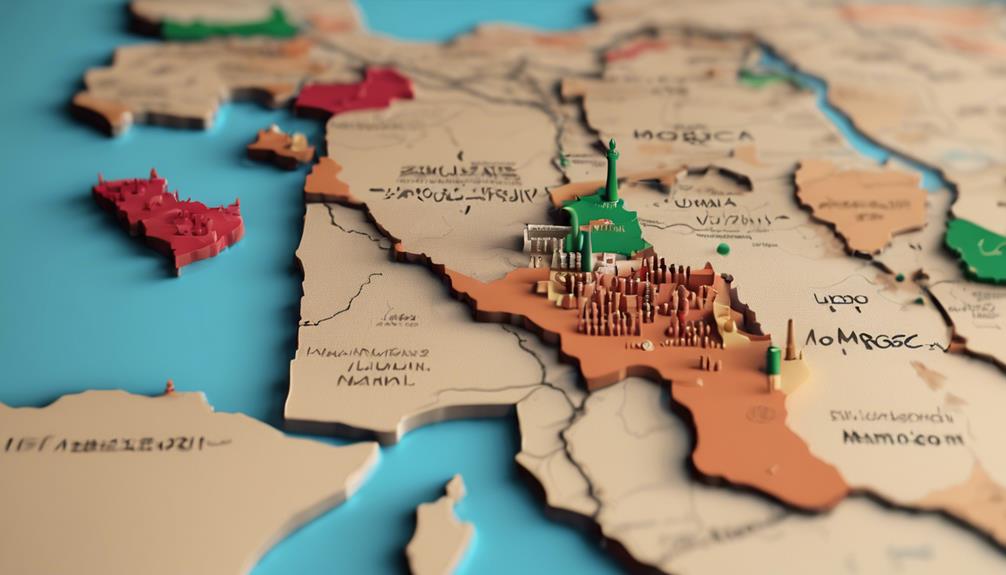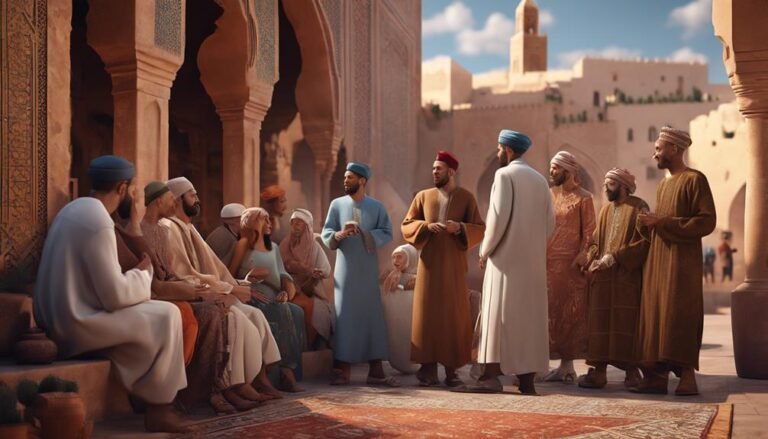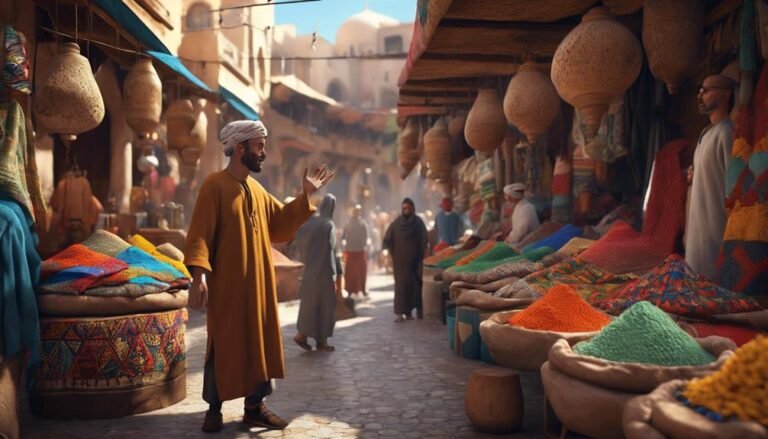Discover the intricate variations in Moroccan dialects through unique syntactic structures, diverse vocabulary choices, distinct pronunciation discrepancies, and varied grammatical patterns across regions. These differences reflect historical, geographical, and cultural influences, shaping the rich linguistic landscape of Morocco.
Key Takeaways
- Syntactic structures vary regionally, impacting communication.
- Lexical disparities exist across Moroccan regions showcasing linguistic diversity.
- Pronunciation discrepancies distinguish dialects, affecting comprehension.
- Grammatical variations include differences in word order and morphology.
- Historical, cultural, and societal influences shape the diverse Moroccan dialects.
Regional Variations in Moroccan Dialects
When examining the differences between Moroccan dialects, it's important to explore the regional variations that shape the linguistic landscape of the country. One key aspect of these regional differences lies in the syntactic structures employed in different areas. For instance, the syntactic structures used in the northern regions of Morocco may differ greatly from those in the southern regions. These syntactic variances can impact how sentences are constructed, leading to distinct communication patterns within each region.
Furthermore, idiomatic expressions play an essential role in distinguishing between Moroccan dialects. Idiomatic expressions are phrases that carry a non-literal meaning understood by native speakers. In Morocco, idiomatic expressions can vary widely from region to region, reflecting unique cultural influences and historical backgrounds. For example, a common idiom in one region may hold a completely different connotation in another. Understanding these idiomatic expressions is vital for grasping the nuances of communication in Moroccan dialects and appreciating the rich diversity present within the country's linguistic tapestry.
Vocabulary Variances Across Moroccan Regions
When analyzing the vocabulary variances across Moroccan regions, it becomes evident that there are significant differences in the lexicon used in various areas.
These regional lexical disparities highlight the linguistic diversity present within Morocco, showcasing the richness and complexity of the country's linguistic landscape.
Understanding these vocabulary variations is crucial for gaining a thorough insight into the nuances of Moroccan dialects.
Regional Lexical Differences
Regional lexical differences in Moroccan dialects exhibit a diverse array of vocabulary variances across various geographical areas. Lexical evolution and semantic shifts have played a significant role in shaping these differences. Below is a table highlighting some examples of regional lexical variances in Moroccan dialects:
| Northern Morocco | Central Morocco | Southern Morocco |
|---|---|---|
| 'Tbarkallah' (Goodness) | 'Ssalam' (Hello) | 'Sbah lkhir' (Good morning) |
| 'Zwin' (Beautiful) | 'Hbib' (Friend) | 'Henna' (Here) |
| 'Tfou' (Disgusting) | 'Tbarkallah' (Goodness) | 'Mlih' (Tasty) |
These examples demonstrate how regional influences have led to unique vocabulary choices in Moroccan dialects.
Linguistic Diversity in Morocco
The linguistic diversity in Morocco is intricately reflected through the varied vocabulary choices found across different regions, showcasing a rich tapestry of language evolution and cultural influences.
Language evolution in Morocco has been shaped by historical interactions with various civilizations, resulting in a diverse linguistic landscape. Each region's unique history and cultural interactions have contributed to the development and preservation of distinct dialects.
Dialect preservation is a crucial aspect of Morocco's linguistic diversity, with communities actively maintaining and passing down their dialects through generations. The vocabulary variances across Moroccan regions not only highlight the richness of the country's linguistic heritage but also serve as a living evidence to the ongoing evolution of language within diverse cultural contexts.
Pronunciation Discrepancies Among Moroccan Dialects
When exploring pronunciation discrepancies among Moroccan dialects, you'll encounter regional accent variations, distinct vowel sound differences, and unique consonant pronunciation distinctions.
These subtle nuances in pronunciation play a significant role in distinguishing between the various Moroccan dialects, reflecting the rich linguistic diversity present in the region.
Understanding these pronunciation variations is essential for effective communication and comprehension across different Moroccan linguistic communities.
Regional Accent Variations
Amidst the diverse Moroccan dialects, variations in regional accents manifest through distinct pronunciation discrepancies that contribute to the rich linguistic tapestry of the country. These differences aren't only intriguing but also reflective of the historical and cultural influences in various regions of Morocco.
When exploring regional accent variations in Moroccan dialects, you may observe:
- Phonological Variations: Different regions may have unique ways of pronouncing certain sounds, leading to variations in accent that are identifiable to specific areas.
- Idiomatic Expressions: Regional accents often influence the use of local idiomatic expressions, creating a colorful linguistic landscape that showcases the diversity of Moroccan culture.
- Rhythmic Patterns: The cadence and rhythm of speech can vary significantly across regions, influencing the overall tonality and musicality of the spoken language.
Vowel Sound Differences
Vowel sound differences in Moroccan dialects present a fascinating insight into the intricate variations of pronunciation across different regions. These variations are the result of dialectical evolution influenced by sociolinguistic factors and historical contexts.
Phonological variations in vowel sounds can be attributed to diverse regional influences that have shaped the spoken language over time. For instance, the pronunciation of vowels in words can differ considerably between urban and rural areas due to distinct sociocultural environments.
Understanding these vowel sound differences is essential for comprehending the rich tapestry of Moroccan linguistic diversity. By delving into the nuances of vowel pronunciation, one can appreciate the complexity of language evolution and the impact of regional accents on spoken communication.
Consonant Pronunciation Distinctions
The distinction in consonant pronunciation among Moroccan dialects reveals a complex web of phonetic variations shaped by historical, sociolinguistic, and regional influences. When examining these nuances, one can observe phonetic shifts that contribute to the rich tapestry of Moroccan dialectal phonology.
Here are some key points to contemplate:
- Consonant Pronunciation Nuances: Various Moroccan dialects exhibit subtle differences in how certain consonants are pronounced, such as the pronunciation of the letter 'qaf' in different regions.
- Regional Speech Patterns: Regional variations in consonant pronunciation can be linked to specific speech patterns unique to certain areas within Morocco.
- Dialectal Phonology: The study of consonant pronunciation distinctions sheds light on the intricate phonological systems present in Moroccan dialects, highlighting the diversity and complexity of the language.
Grammatical Variances in Moroccan Regional Dialects
What're the key grammatical variances observed in the regional dialects of Morocco?
In Moroccan regional dialects, syntactic structures and morphological differences play important roles in distinguishing one dialect from another. Syntactic structures refer to how words are arranged to form sentences, and these structures can vary greatly between dialects. For example, in some regions, the word order might follow a Subject-Verb-Object pattern, while in others, it could be Verb-Subject-Object.
Morphological differences, on the other hand, pertain to changes in the form of words to indicate different meanings or grammatical functions. These differences can manifest in various ways, such as changes in verb conjugation, noun declension, or the formation of plurals. For instance, the way in which verbs are conjugated in different dialects can vary significantly, leading to distinct grammatical nuances.
Understanding these grammatical variances is important for grasping the full complexity and richness of Moroccan dialects. By delving into the syntactic structures and morphological differences present in regional dialects, one can appreciate the diversity and intricacies of language variation across Morocco.
Influences on Moroccan Dialect Diversity
In exploring the influences on the diversity of Moroccan dialects, it becomes evident that external factors and historical developments have played significant roles in shaping the linguistic landscape of the region. The influences on Moroccan dialect diversity have been shaped by a combination of factors:
- Historical Influences: The history of Morocco, including periods of Arab, Berber, and French rule, has left lasting linguistic legacies on the country's dialects. Each of these influences has contributed to the unique characteristics found in different regions.
- Geographical Factors: The diverse geography of Morocco, from the Atlas Mountains to coastal regions and deserts, has also had an impact on dialect evolution. Isolation due to natural barriers has led to the development of distinct dialectal features in different areas.
- Cultural Exchange: Trade routes, migrations, and cultural interactions with neighboring regions and beyond have introduced new words, expressions, and linguistic elements into Moroccan dialects, enriching the linguistic tapestry of the country.
Historical Factors Shaping Moroccan Dialects
During the medieval period, diverse linguistic influences from various conquerors and settlers greatly shaped the evolution of Moroccan dialects. The colonial impact and language evolution profoundly molded the linguistic landscape of Morocco. Trade routes played a vital role in facilitating linguistic exchange and the spread of different languages across the region. These historical factors have left lasting imprints on Moroccan dialects, contributing to their rich diversity and unique characteristics.
To illustrate the complexity of historical influences on Moroccan dialects, consider the following table:
| Historical Factors | Description | Impact |
|---|---|---|
| Colonial Impact | Foreign colonization introduced new languages | Altered vocabulary and grammar structures |
| Language Evolution | Continuous linguistic changes over time | Resulted in the formation of distinct dialects |
| Trade Routes | Cross-cultural interactions through commerce | Facilitated the blending of different languages |
The interplay of these factors showcases how Moroccan dialects have evolved over time, reflecting the country's rich history and diverse cultural interactions.
Cultural Influences on Moroccan Language Variations
Cultural influences in Morocco have played a significant role in shaping the variations observed in Moroccan language. These influences have impacted language evolution and cultural assimilation in the region. Here are three key ways in which cultural influences have contributed to the diversity of Moroccan dialects:
- Historical Conquests: Throughout history, Morocco has been influenced by various civilizations such as the Arabs, Berbers, and Europeans. Each of these cultural groups left a linguistic imprint on the region, leading to the incorporation of diverse vocabulary, pronunciation, and grammatical structures into Moroccan dialects.
- Religious Practices: The dominant religion in Morocco is Islam, which has influenced the language through the incorporation of Arabic terms related to religious practices and rituals. This integration of religious vocabulary has contributed to the distinctiveness of Moroccan dialects compared to other Arabic varieties.
- Culinary Traditions: Moroccan cuisine is renowned for its rich flavors and diverse ingredients. As a result, culinary terms and food-related expressions have found their way into everyday language, further enriching the linguistic landscape of Morocco.
Sociolinguistic Aspects of Moroccan Dialects
Incorporating sociolinguistic analyses reveals intricate relationships between societal structures and linguistic variations in Moroccan dialects. Sociolinguistic dynamics play an important role in shaping the linguistic landscape of Morocco, reflecting the diverse social contexts in which these dialects are spoken. The dialectical variations present in Moroccan Arabic highlight the complex interplay between language evolution and societal influences. These variations aren't only linguistic but also carry significant social and cultural connotations, contributing to the construction of individual and group linguistic identity.
Language is a dynamic entity, constantly evolving within the framework of societal norms and structures. The sociolinguistic aspects of Moroccan dialects provide insights into the intricate web of relationships that exist between language, culture, and society. Understanding these dynamics is essential for comprehending the nuances of communication within Moroccan communities and the broader implications for linguistic identity.
Future Trends in Moroccan Dialect Development
Examining the trajectory of Moroccan dialect development reveals forthcoming linguistic shifts influenced by societal dynamics and cultural adaptations. As language evolves, several future trends in Moroccan dialect development are anticipated:
- Evolving Slang Terms: The incorporation of new slang terms into Moroccan dialects is expected to continue as younger generations introduce innovative vocabulary influenced by global trends and digital communication platforms.
- Language Evolution Trends: Moroccan dialects are likely to undergo further simplification and standardization, especially in urban areas, as speakers seek mutual intelligibility and linguistic cohesion across regions.
- Influence of Media and Technology: With the increasing influence of media and technology on language usage, Moroccan dialects are poised to adopt more loanwords from foreign languages, particularly English, reflecting the interconnectedness of modern society.
These trends signify a dynamic linguistic landscape where Moroccan dialects adapt to societal changes and embrace a blend of traditional elements with contemporary influences.
Conclusion
As you journey through the diverse landscape of Moroccan dialects, you'll discover a tapestry woven with historical threads, cultural influences, and sociolinguistic nuances.
Like a mosaic of linguistic colors, each regional variation adds depth and richness to the vibrant tapestry of Moroccan language.
Embrace the differences, for they're the threads that bind us together in a beautiful symphony of diversity.
The future of Moroccan dialects holds the promise of continued evolution and growth, reflecting the dynamic nature of language itself.

The Editorial Team is a passionate group of Morocco enthusiasts dedicated to sharing the beauty, culture, and wonders of this captivating country. With diverse backgrounds and a deep love for travel, we strive to bring you engaging and informative content that inspires your Moroccan adventures. From uncovering hidden gems and sharing local insights to exploring mouthwatering cuisine and showcasing the vibrant lifestyle, our team is committed to providing you with valuable resources and exciting stories that enhance your exploration of Morocco. Join us on this journey as we celebrate the rich heritage and unforgettable experiences that make Morocco truly special.







